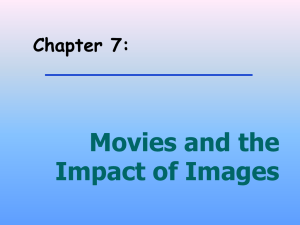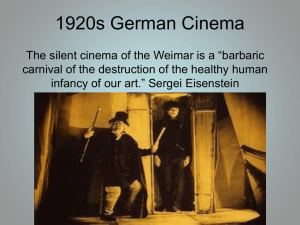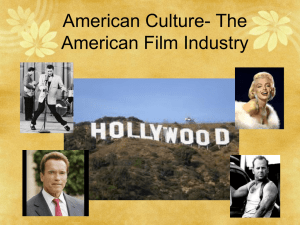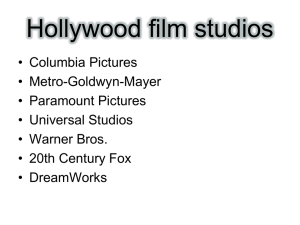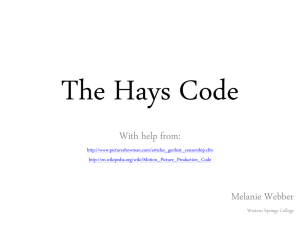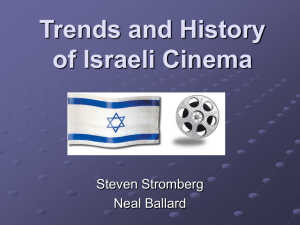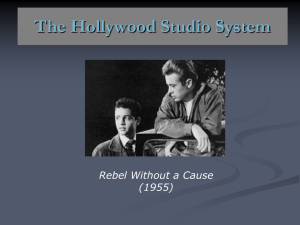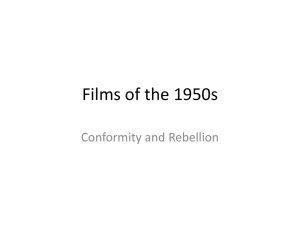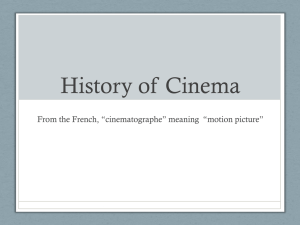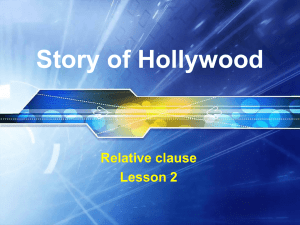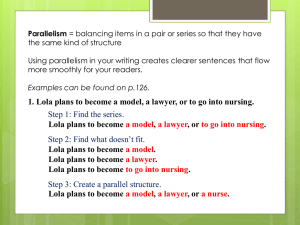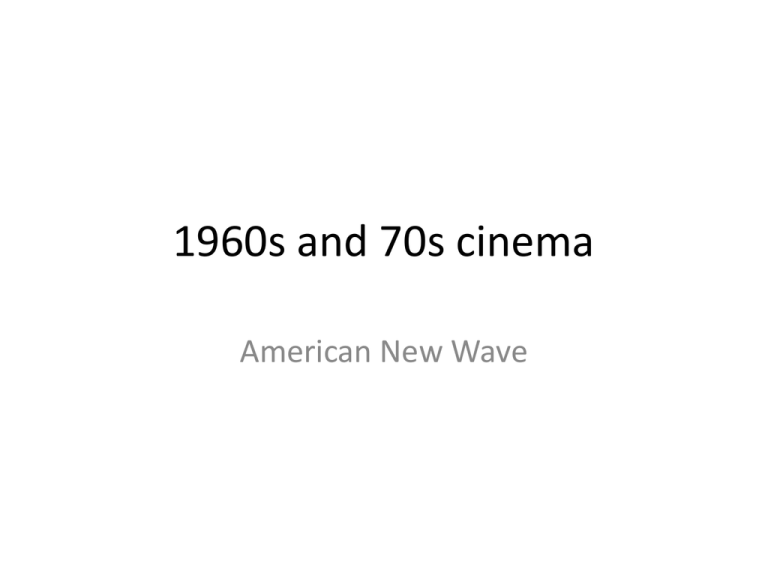
1960s and 70s cinema
American New Wave
Problems facing post-WWII America
• Attendance losses
– By the mid-1960s had reached alarmingly low levels.
– Changing audience demographics:
• Before: Middle aged, high school educated audience
• Now: younger, college-educated, more affluent audience; by the mid
70s, 76% of all movie-goers were under 30, and 64% had gone to
college.
• -European market:
– European art films (especially the Commedia all'italiana, the
French New Wave, and the Spaghetti Western) and Japanese
cinema were making a splash in America
• The huge market of disaffected youth seemed to find relevance and
artistic meaning in movies
• -Rise of TV
Evolution of New Cinema
•
•
•
•
-Television made older audience stay home
-New Wave French influence
-Underground cinema—avant garde
-Film as an art form—colleges and universities
Types of films
•
•
•
•
-alienation films
-rebellion films
-ideological films
-soundtrack
New American Cinema
• -Subconsciously concerned with style
• -1970s moving away from what we were doing
before, start focusing on auteur style
• -Shift away from genre
New Hollywood
• Post-classical Hollywood – AKA "American New Wave”
– Roughly the mid-1960s (Bonnie and Clyde, The Graduate) to the early 1980s
(Heaven's Gate, One from the Heart)
– New generation of young filmmakers came to prominence in America
– Influencing the types of films produced, their production and marketing, and
impacted the way major studios approached filmmaking.
• The films they made were part of the studio system -- not "independent
filmmakers” but they introduced subject matter and styles that set them apart
from the studio traditions.
• New Hollywood has also been defined as a broader filmmaking movement
influenced by this period, which has been called the “Hollywood renaissance”
• Studios desperate during this period after losses from expensive movie flops
– led to innovation and risk taking
– Greater control by younger directors and producers in an attempt to capture that
audience which found a connection to the “art films” of Europe
– Studios hired a host of young and allowed them to make their films with relatively
little studio control.
• Breakdown of the Production Code in 1966 and the new ratings system in
1968
Characteristics of the New Hollywood
films
• New generation of Hollywood filmmaker: film schooleducated, counterculture-bred, and young
– Able to reach the youth audience Hollywood was losing.
– This group of young filmmakers — actors, writers and directors —
dubbed the New Hollywood by the press, briefly changed the
business from the producer-driven Hollywood system of the past,
to films with fresh energy, sexuality, and a passion for the artistic
value of film itself.
• Greatest change: emphasis on realism.
– Motion Picture Association of America film rating system was
introduced
– Location shooting was becoming more viable. Because of
breakthroughs in film technology—filmmakers could shoot 35mm
camera film in exteriors with relative ease.
• Location shooting cheaper (no sets need be built) so, New Hollywood
filmmakers were attracted to it – also heightened the realism
Characteristics of the New Hollywood
films continued
• The use of editing to artistic effect was also an important
factor in New Hollywood cinema
• New Hollywood films often featured anti-establishment
political themes, use of rock music, and sexual freedom
deemed "counter-cultural" by the studios.
• Many figures of the period openly admit to using drugs
such as LSD and marijuana.
• The popularity of these films with young people shows the
importance of these thematic elements and artistic values
with a more cinematically knowledgeable audience.
• The youth movement of the 1960s turned anti-heroes like
Bonnie and Clyde into pop culture heroes
Bonnie and Clyde
•
•
Many considered B&C the most significant film for the New Hollywood generation
Considered a landmark film—one of the first films of the New Hollywood era
– broke many taboos and was popular with the younger generation
•
•
•
•
Released in 1967.
Produced by and starring Warren Beatty
Directed by: Arthur Penn
Cast
–
–
–
–
–
•
•
Warren Beatty as Clyde Barrow
Faye Dunaway as Bonnie Parker
Michael J. Pollard as C.W. Moss
Gene Hackman as Buck Barrow
Estelle Parsons as Blanche Barrow
Its mix of graphic violence, sex and humor as well as its theme of glamorous
disaffected youth was a hit with audiences
Received Academy Awards for Best Supporting Actress and Best Cinematography.
Critical Reviews
•
•
•
•
Its portrayal of violence and ambiguity in regard to moral values, and ‘shock’ ending, divided critics.
Following a negative review, Time magazine received letters from fans of the movie
The impact of critic Pauline Kael in her positive review of the film (October 1967 New Yorker) led other
reviewers to follow her lead and re-evaluate the film (notably Newsweek and Time)
Kael drew attention to the innocence of the characters in film and the artist merit of the contrast with the
violence in the film:
–
•
•
•
•
“In a sense, it is the absence of sadism — it is the violence without sadism — that throws the audience off balance
at Bonnie and Clyde. The brutality that comes out of this innocence is far more shocking than the calculated
brutalities of mean killers”.
Kael also noted the reaction of audiences to the violent climax of the movie, and the potential to
empathize with the gang of criminals in terms of their naiveté and innocence reflecting a change in
expectations of American cinema.
The cover story in Time Magazine in December 1967, celebrated the movie and innovation in American
New wave cinema.
This influential article by Stefan Kanfer claimed that Bonnie and Clyde represented a "New Cinema"
through its blurred genre lines, and disregard for honored aspects of plot and motivation, and that “In
both conception and execution, Bonnie and Clyde is a watershed picture, the kind that signals a new
style, a new trend.”
Biskind states that this review and turnaround by some critics allowed the film to be rereleased thus
proving its commercial success and reflecting the move to New Hollywood.
Impact of Bonnie and Clyde
• Its success motivated other filmmakers to be more forward about
presenting sex and violence in their films.
• The impact of this film is important in understanding the rest of the
American New Wave, as well as the conditions that were necessary
for it.
• These initial successes paved the way for the studio to relinquish
almost complete control to these innovative young filmmakers.
• In the mid-1970s, idiosyncratic, startling original films such as Paper
Moon, Dog Day Afternoon, Chinatown and Taxi Driver among
others, enjoyed enormous critical and commercial success. These
successes by the members of New Hollywood led each of them in
turn to make more and more extravagant demands, both on the
studio and eventually on the audience.



